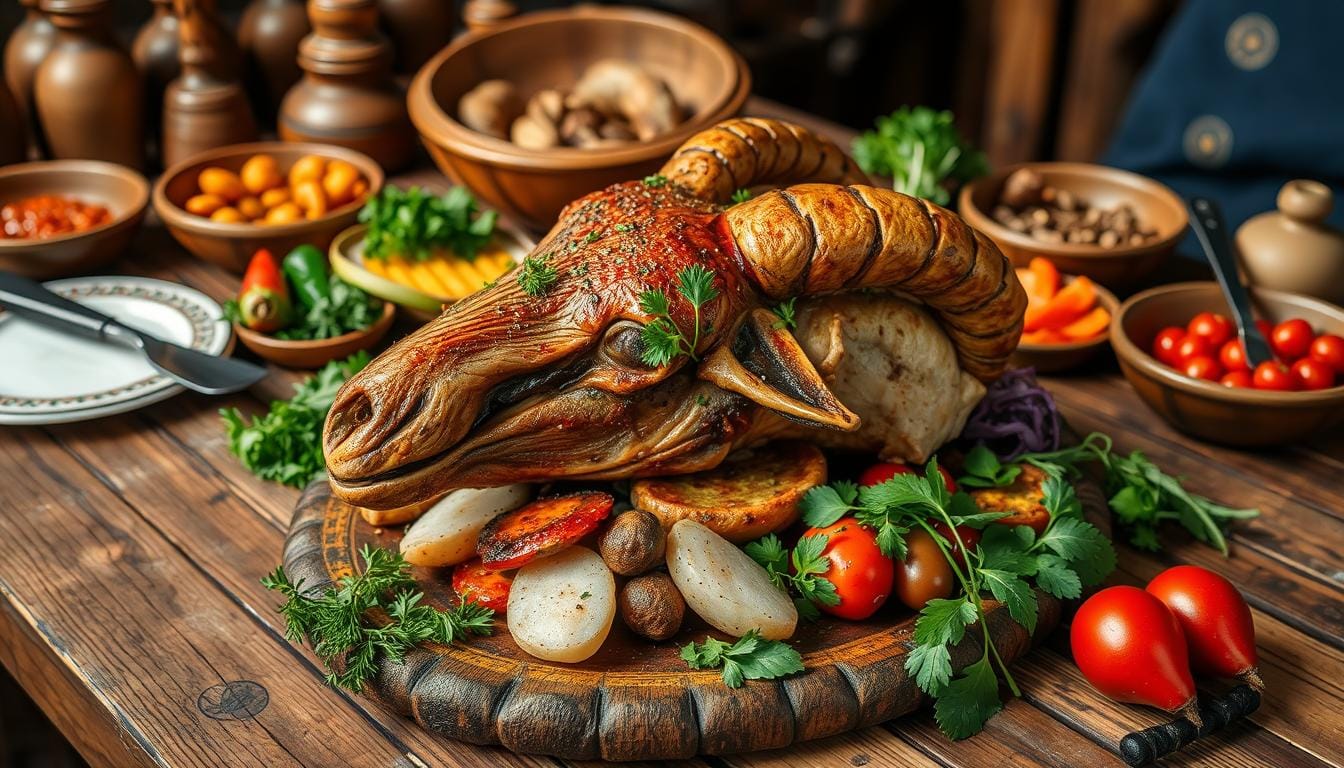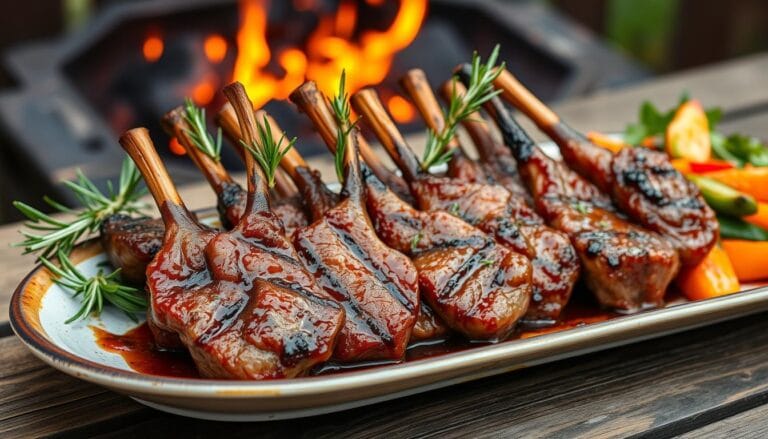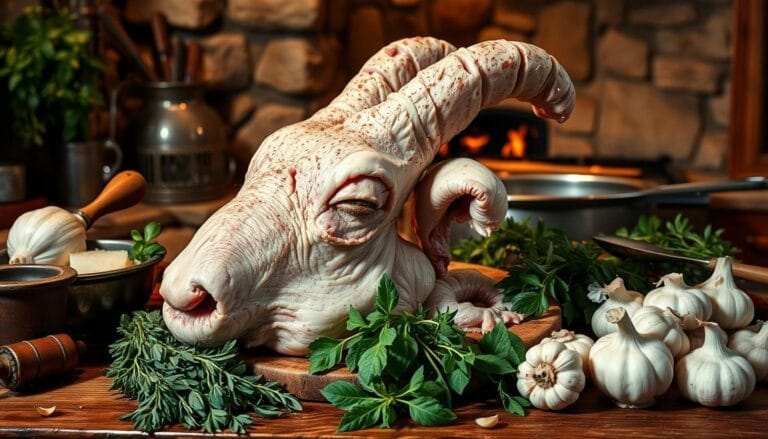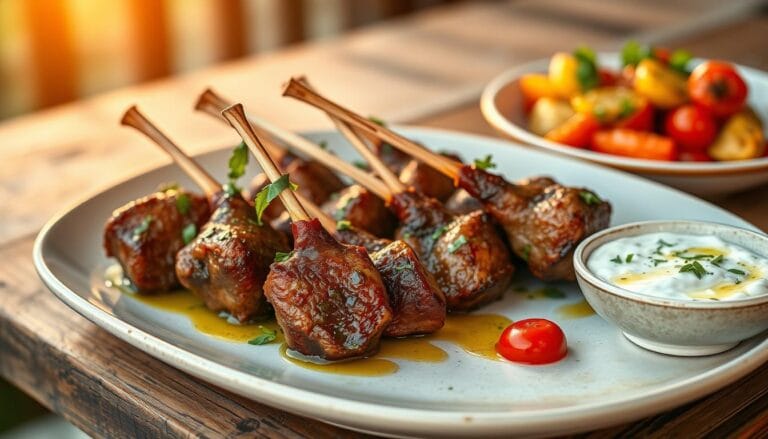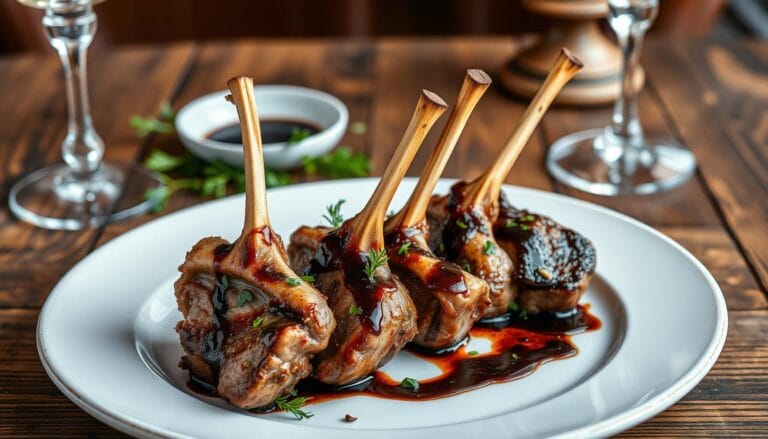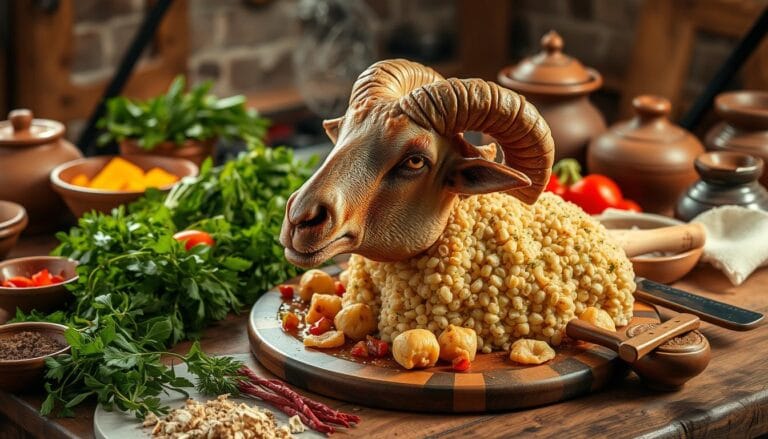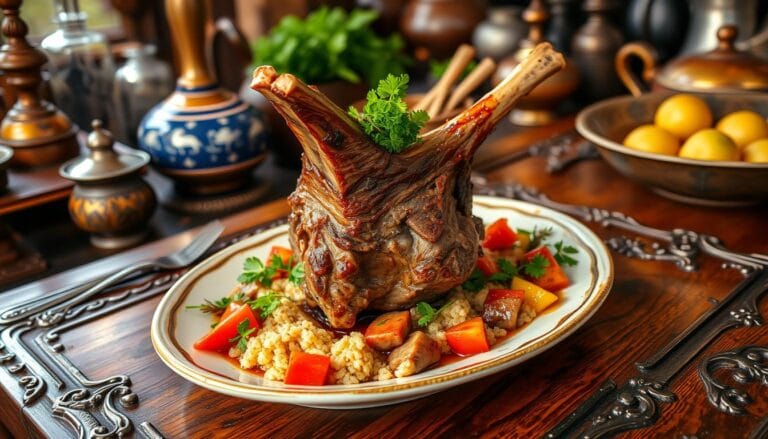Sheep Head Food: Exploring the Dish
When you first hear about sheep head food, you might feel curious and a bit unsure. This traditional dish is more than just a meal. It’s a journey that connects people across generations and cultures through food.
Sheep head food has a rich story of survival and respect for animals. It comes from Western Norway and is enjoyed worldwide. This dish celebrates the whole animal, making it a feast of taste and tradition.
Smalahove, a Norwegian specialty, shows how communities used every part of an animal. What might seem strange to some is a beloved dish in places like Sogn og Fjordane and Hordaland.
Table of Contents
What is Sheep Head Food?
Sheep head cuisine is a unique part of ethnic food traditions. It uses the whole animal, making a tasty and healthy dish. This practice is found in many cultures.
Lamb head cuisine is more than just cooking. It shows how to use every part of the animal. This way of cooking has been around for a long time. It helps use all parts of the animal and reduces waste.
Understanding the Ingredients
The main ingredients for sheep head dishes are:
- Entire sheep head (cleaned thoroughly)
- Salt and traditional spices
- Water for boiling or roasting
- Optional regional seasonings
Cultural Significance
“In our tradition, every part of the animal tells a story of survival and respect.”
Smalahove, a dish from Norway, shows how important sheep head food is. It’s eaten during winter holidays. This brings people together through food.
| Region | Preparation Method | Cultural Significance |
|---|---|---|
| Norway | Boiled/Roasted | Winter celebration tradition |
| Iceland | Fermented | Preserving food heritage |
| Middle Eastern Regions | Spiced and Grilled | Community gathering ritual |
Each cooking method shows local traditions. It shows how using the whole animal is more than just food. It’s a deep cultural expression.
The History of Sheep Head in Cuisine
Sheep head cuisine is a journey through culinary traditions. It shows how sustainable meat consumption and nose-to-tail dining have evolved. This unique dish has changed a lot over the centuries.
In the Viking Age, sheep were more than just food. They were essential for survival. Sheep provided wool for clothes and sails, and their meat was scarce.
Roots in Culinary Traditions
Sheep head dishes started from necessity. Communities used the whole animal to avoid waste and get more nutrition. This early approach to meat is still important today.
- Preserved food techniques developed from limited resources
- Nose-to-tail dining became a survival strategy
- Cultural identities formed around resourceful cooking methods
Evolution of Preparation Methods
How we prepare sheep head dishes has changed a lot. What was once basic cooking is now a sophisticated art. Today, these dishes are celebrated in cultural events.
“Every part of the animal tells a story of human adaptation and creativity in cuisine.” – Anonymous Culinary Historian
Today, chefs are finding new ways to make sheep head dishes. They mix old cooking methods with new ideas. Exploring this tradition is both fun and tasty.
Popular Variations of Sheep Head Dishes
Sheep head dishes take us on a journey through different cultures. They show how various traditions prepare sheep skulls in unique ways.
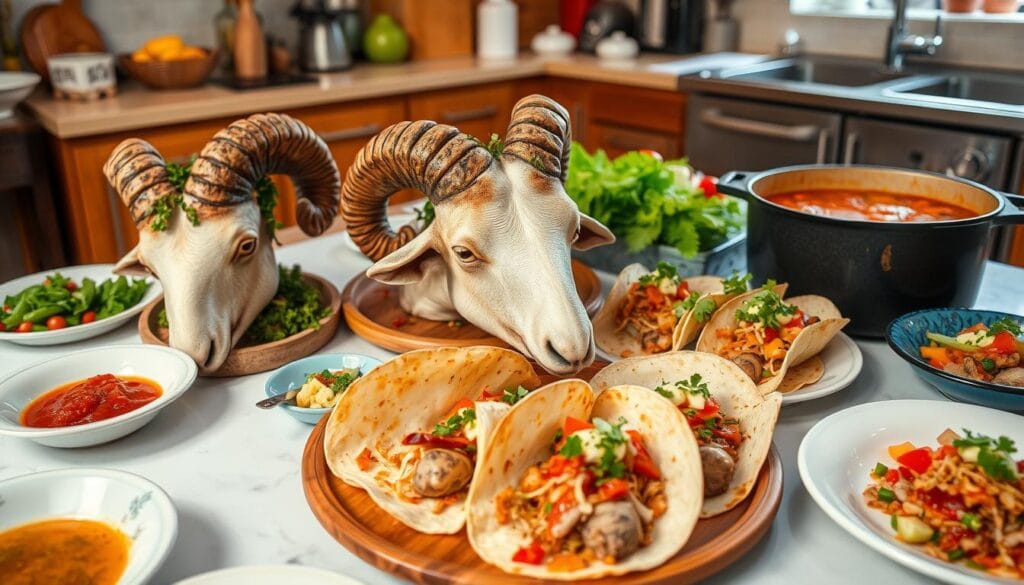
Diverse cultures have their own ways of making and enjoying sheep head dishes. Let’s look at some interesting regional variations:
Global Sheep Head Preparation Styles
- Icelandic Svið: A traditional dish where the sheep head is singed and boiled, keeping its shape
- Middle Eastern Kaleh Pacheh: A breakfast dish with slow-cooked sheep head and feet
- Scandinavian Sviðasulta: A unique jelly-like dish made from pressed sheep head meat
Unique Ingredients in Sheep Head Cuisine
Sheep head dishes from different places use a variety of ingredients. These reflect local cooking traditions. Some interesting ingredients include:
- Aromatic spices like cinnamon and turmeric
- Whole vegetables such as onions and garlic
- Traditional sides like flatbreads and pickled garnishes
“The eyes of the sheep are considered the best part” – Traditional Culinary Wisdom
Cooking sheep head dishes can take 4-6 hours. This shows the care needed to make it a tasty meal. Knowing these regional differences helps us understand the cultural value of this tradition.
How to Prepare Sheep Head at Home
Preparing sheep head food at home might seem tough, but it’s doable with the right tools and guidance. It takes patience, skill, and attention to detail to prepare a sheep skull.
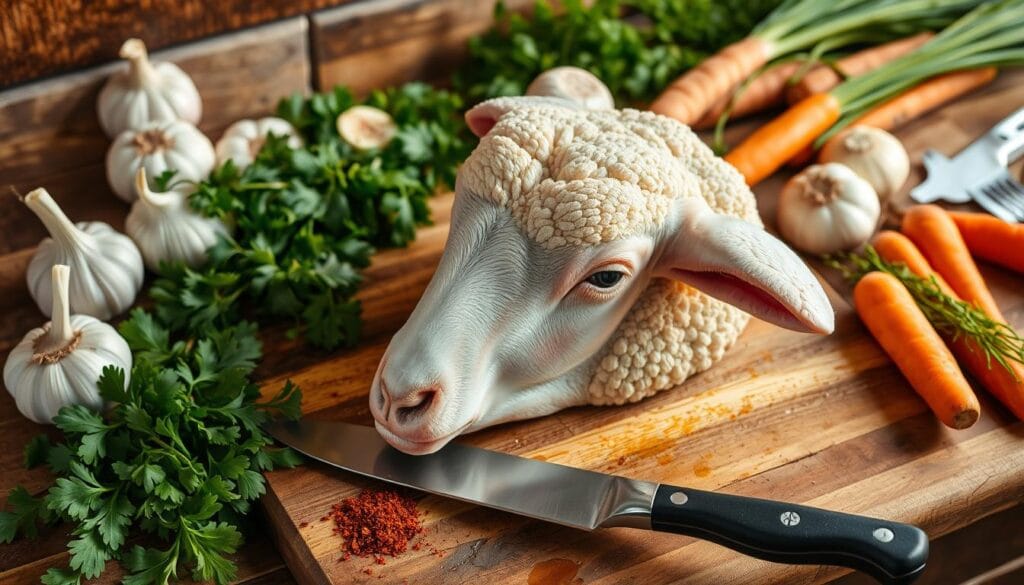
Before starting to cook, you’ll need some essential tools and ingredients for your sheep head culinary adventure.
Essential Cooking Tools
- Large stock pot or Dutch oven
- Sharp butcher’s knife
- Cutting board
- Kitchen tongs
- Roasting pan
- Meat thermometer
Ingredient Checklist for Sheep Head Cuisine
| Ingredient | Quantity |
|---|---|
| Cleaned sheep head | 2 |
| Butter | 30 ml |
| Olive oil | 30 ml |
| Onions | 3 (quartered) |
| Garlic cloves | 5 (crushed) |
| Bay leaves | 3 |
Step-by-Step Cooking Guide
- Clean the sheep head thoroughly, removing any remaining hair
- Prepare a flavorful broth with white wine and chicken stock
- Slowly simmer the sheep head for 3-4 hours until meat is tender
- Season with za’atar and sumac for authentic flavor
- Let the dish rest and refrigerate overnight to set
“Cooking sheep head is an art that connects you to ancient culinary traditions.” – Traditional Chef
Remember, sheep head food needs careful preparation. The total cooking time is about 2 hours, with prep taking around 1 hour. This recipe serves 4-6 people and is packed with protein and essential vitamins.
Where to Find Sheep Head Dishes
Exploring traditional meat delicacies is an exciting journey. If you want to try sheep head cuisine, you have many options.

Starting your adventure in ethnic food traditions means knowing where to find these dishes. Whether you love food or are just curious, finding authentic sheep head cuisine takes some insider tips.
Local Restaurants and Regional Specialties
Different places have their own way of making this cultural dish. Some key spots include:
- Voss, Norway: The heart of smalahove (traditional sheep head cooking)
- Western Norwegian restaurants known for their local dishes
- Special ethnic restaurants in big cities
Online Resources for Culinary Explorers
| Resource Type | Description | Recommended For |
|---|---|---|
| Specialty Cookbooks | Guides on how to make traditional dishes | Home cooks and food lovers |
| Ethnic Food Websites | Online places with real recipes | People who collect recipes online |
| Cultural Food Blogs | Personal stories and local tips | Those who explore cultural foods |
“Food is our common ground, a universal experience.” – James Beard
Trying sheep head dishes is more than just eating. It’s about learning about cultural traditions and connecting with food heritage.
Nutritional Value of Sheep Head
Exploring offal dishes like sheep head shows it’s a nutrient-rich food. It supports eating meat in a sustainable way. By using the whole animal, you get amazing health benefits often missed in today’s diets.
Protein Powerhouse
Sheep head meat is packed with protein, beating many common meats. A single serving gives you a lot of protein. This is key for building and keeping muscles strong.
- High-quality protein source
- Contains essential amino acids
- Supports muscle growth and repair
Vitamin and Mineral Composition
Sheep head is full of important vitamins and minerals. These nutrients are vital for staying healthy.
| Nutrient | Content | Health Benefit |
|---|---|---|
| Vitamin B12 | 72% Daily Value | Supports neurological function |
| Calcium | 36% Daily Value | Strengthens bones |
| Zinc | 10-20% Daily Value | Boosts immune system |
“Eating sheep head is not just a culinary adventure, but a nutritional journey through traditional food wisdom.” – Traditional Food Historian
Adding sheep head to your meals is a unique culinary experience. It also helps with sustainable meat eating. This way, you reduce food waste.
Tips for Cooking Sheep Head
Cooking sheep head needs skill and patience. It’s more than a trend; it’s an art form. It celebrates every part of the animal. Whether you’re trying lamb head cuisine or a traditional dish, mastering the technique can change your cooking experience.
Common Mistakes to Avoid
Preparing sheep head can be tough for beginners. Here are some mistakes to avoid:
- Skipping the cleaning process thoroughly
- Using inappropriate cooking temperatures
- Neglecting seasoning techniques
- Overcooking or undercooking the meat
Flavor Pairings to Enhance Taste
Choosing the right flavors can make your sheep head dish stand out. Try these pairings:
- Acidic elements like lemon or vinegar to cut through richness
- Herbs such as rosemary and thyme for depth
- Spicy accompaniments to contrast the meat’s intense flavor
- Roasted vegetables for complementary textures
“Cooking sheep head is about respecting tradition while embracing culinary creativity.” – Chef Marco Rodriguez
When cooking lamb head, slow cooking is essential. Use temperatures between 300-325°F for 3-4 hours. This makes the meat tender and flavorful. Baste often to keep it moist and develop rich flavors.
The Experience of Eating Sheep Head
Exploring sheep head cuisine opens up a world of cultural richness. It’s more than just food; it’s a deep social bond. This traditional dish connects people through shared traditions.
Social Dimensions of Shared Meals
Eating sheep head is a communal affair. It brings people together, creating lasting memories. In many cultures, it’s a ritual that strengthens family ties.
- Gather friends and family around the table
- Share stories while enjoying the meal
- Learn traditional preparation techniques
- Respect cultural eating rituals
Navigating the Culinary Adventure
Trying sheep head for the first time can be daunting. But, approach it with an open mind and respect. Embrace the experience without judgment.
“Food is our common ground, a universal experience.” – James Beard
Recommended Dining Companions
| Drink Pairing | Cultural Origin | Flavor Profile |
|---|---|---|
| Beer | Nordic Tradition | Robust and Complementary |
| Aquavit | Norwegian Heritage | Sharp and Spirited |
Enjoying sheep head is a unique culinary adventure. Each bite shares a story of tradition, skill, and pride.
Conclusion: Embracing Sheep Head Food
Exploring sheep head food is more than just a new dish. It’s about sustainable eating and cultural heritage. By trying nose-to-tail dining, you join a global tradition that values food and cooking diversity.
Sheep head dishes connect us to our culinary past. Learning about them helps keep important food traditions alive. Your interest in these dishes can also support sustainable farming and local farmers.
Your Next Steps in Culinary Exploration
Look for local restaurants that serve traditional meat dishes. Ask them about their food sources and the history of sheep head cuisine. Try cooking these dishes at home to learn about regional traditions and sustainable eating.
Encouragement to Try New Flavors
Don’t be scared of new ingredients or cooking ways. Every new dish you try broadens your view of global food. Embracing sheep head food opens a world of flavors that challenges our usual eating habits and supports sustainable farming.
FAQ
What exactly is sheep head food?
Sheep head food is a traditional dish made from a sheep’s head. It includes parts like cheeks, tongue, and brain. These are cooked in various ways across cultures.
Is eating sheep head safe and nutritionally beneficial?
Yes, it’s safe and full of nutrients. It has proteins, vitamins, and minerals like iron and zinc. Eating the whole head is good for the environment and follows traditional ways of using animals.
What are some popular cultural preparations of sheep head?
Many cultures have their own ways of cooking it. For example, the Norwegian Smalahove, Icelandic svið, and Middle Eastern qawarma. Each dish has its own flavors and meanings, from festive to everyday.
How do I prepare sheep head at home?
First, clean it well. You might need to singe off hair and remove parts. Then, cook it by boiling, roasting, or smoking. You’ll need a sharp knife, a big pot, and cleaning tools. Make sure to cook it safely and thoroughly.
What does sheep head taste like?
It tastes rich and meaty. Different parts have their own textures and flavors. The cheeks are tender, while other parts are more robust. How you season and cook it affects the taste.
Is sheep head food considered a delicacy or survival food?
It started as a survival food in communities that used the whole animal. Now, it’s a celebrated dish in many cultures. It’s valued for its unique taste, cultural importance, and sustainable eating.
Are there any dietary considerations when eating sheep head?
It’s rich in nutrients but high in cholesterol and fat. People with certain diets or health issues should talk to doctors first. Make sure to get it from trusted sources and cook it right to avoid health problems.
How does sheep head food relate to sustainable eating?
It’s a key part of sustainable eating. Using the whole animal reduces waste and honors traditional cooking. It shows a complete way to eat animal protein.
Source Links
- https://www.foodlorecentral.com/strange-eats/sheeps-head/ – Smalahove: Norwegian Sheep’s Head Delicacy | Traditional Cuisine Guide
- https://uk.finance.yahoo.com/news/history-christmas-dinner-steamed-sheep-023412361.html – The history of Christmas dinner, from steamed sheep’s head to traditional turkey
- https://perlan.is/articles/traditional-icelandic-food – Learn About Traditional Icelandic Food | Perlan
- https://www.hamisharafi.com/free-recipes/kaleh-pacheh – Kaleh Pacheh Recipe — I got it from my Maman
- https://www.nordicvisitor.com/blog/6-thorrablot-foods-for-the-culinarily-brave/ – 6 Þorrablót Foods for the Culinarily Brave : Nordic Visitor
- https://anycreek.com/academy/sheepshead-recipe-two-ways – Two Most Delicious Sheepshead Recipes | moist, succulent, tender, delicious, fried, and healthy (Updated Mar 2024)
- https://mynhardt.co.za/recipe/turkish-lambs-head/ – Turkish Lambs Head – Chef Mynhardt
- https://culinarycreationss.com/posts/svioasulta-jellied-sheep-s-head – Svioasulta – Jellied Sheep’s Head
- https://www.countryfile.com/christmas/christmas-world-foods – Narwhal skin, sheep’s head, fermented fish – 10 curious Christmas dishes from around the world
- https://nutrivore.com/foods/sheep-milk-nutrients/ – Sheep Milk Nutrients
- https://delcambremarket.org/sheepshead-seafood-of-the-month/ – Sheepshead: Seafood of The Month
- http://extension.msstate.edu/publications/market-lamb-project-guide-nutrition – Market Lamb Project Guide: Nutrition
- https://pitmaster.amazingribs.com/forum/the-pit-mastery-program/lamb-recipes/1563209-does-anyone-have-a-good-capuzzelle-recipe – Does anyone have a good capuzzelle recipe?
- https://www.chefturko.com/sheeps-head-terrine-turkish-sogus/ – Sheep’s head terrine – Turkish Söğüş – ChefTurko
- https://www.tastymeatrecipes.net/best-lamb-head-recipe-ever/ – Best Lamb Head Recipe Ever – Traditional Middle East Dish
- https://whereandwander.com/jemaa-el-fna-best-place-mechoui-alley/ – The Best Place To Eat Mechoui and Sheep Brain In Jemaa El-Fna | Where and Wander
- https://sheepshoesandfood.com/ – Sheep, Shoes and Food
- https://ecologyandsociety.org/vol29/iss4/art37/ – Ecology & Society: Overcoming collapse of farming systems: shifting from vicious to virtuous circles in the extensive sheep farming system in Huesca (Spain)

